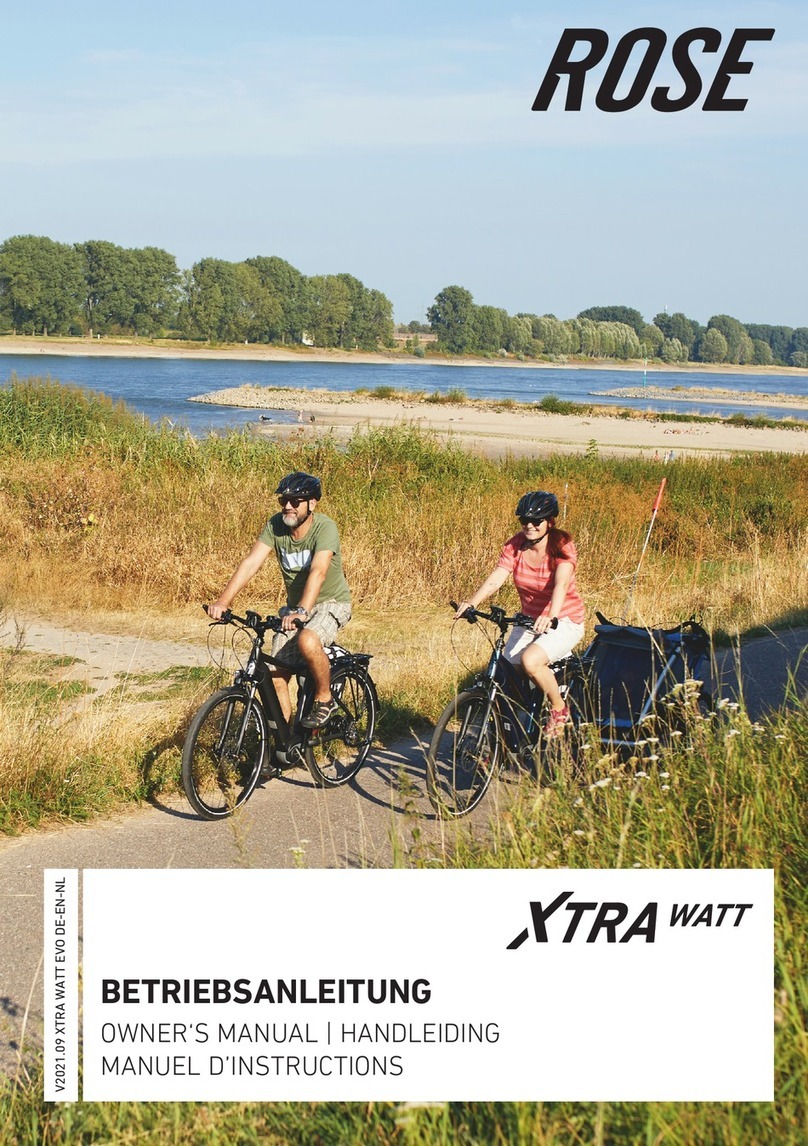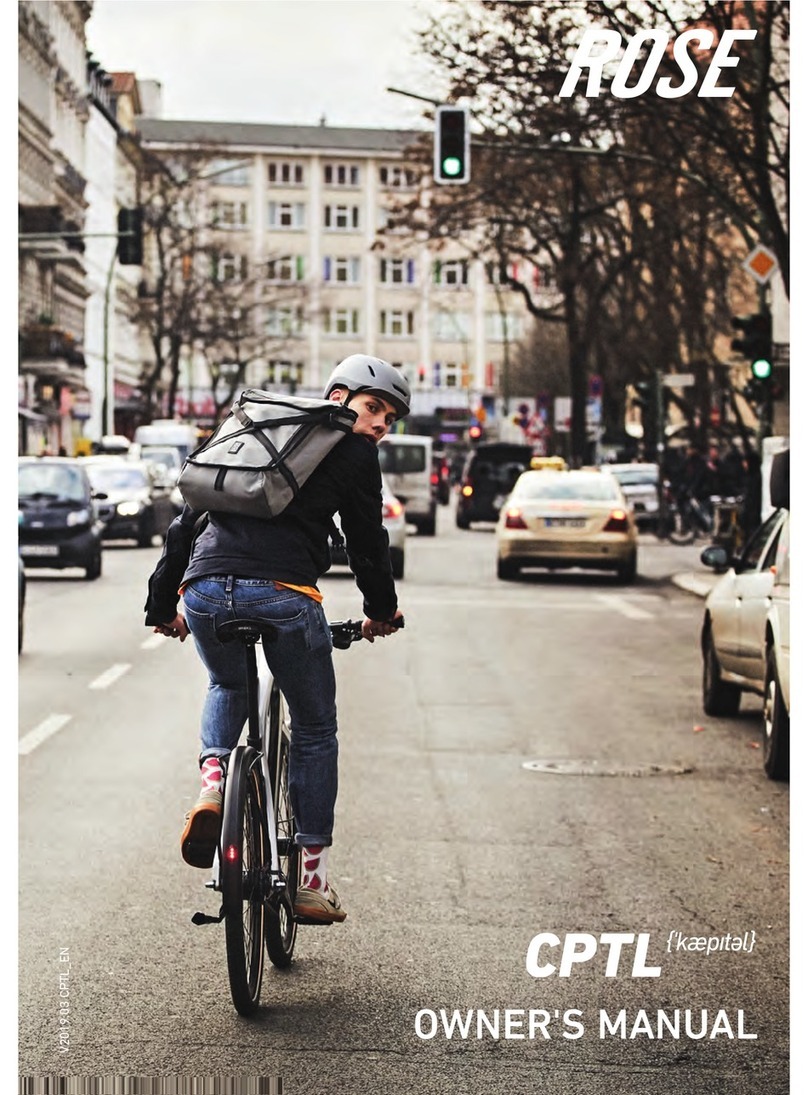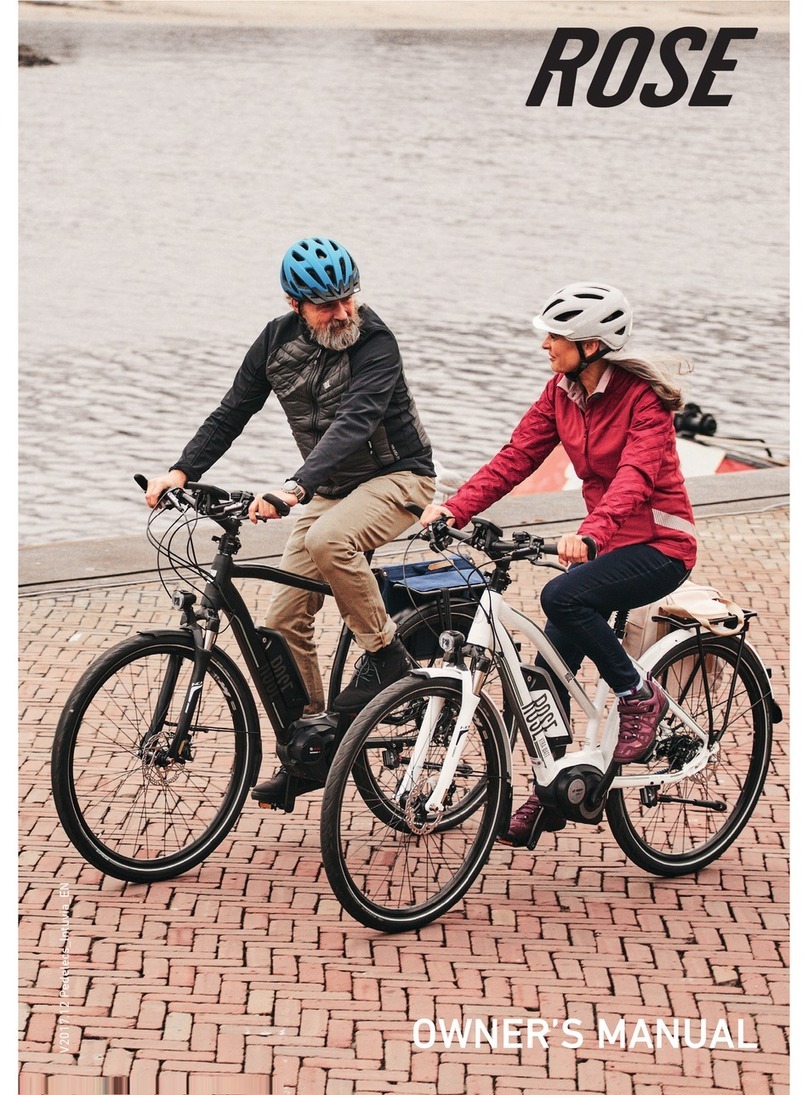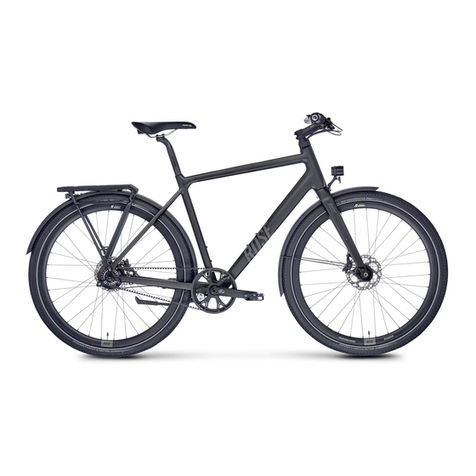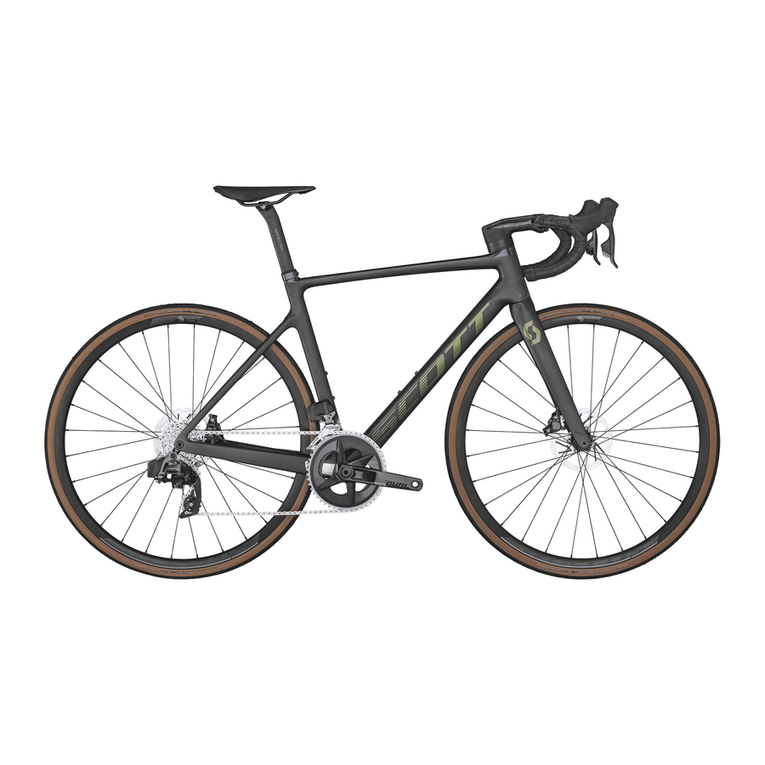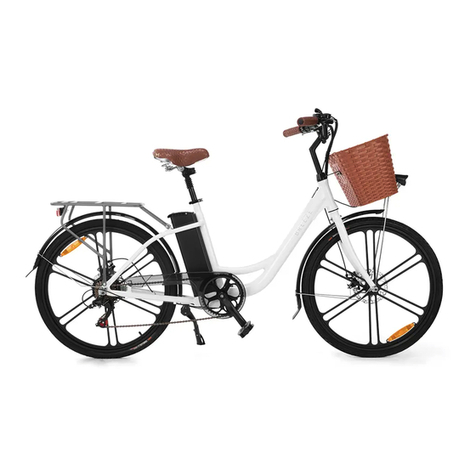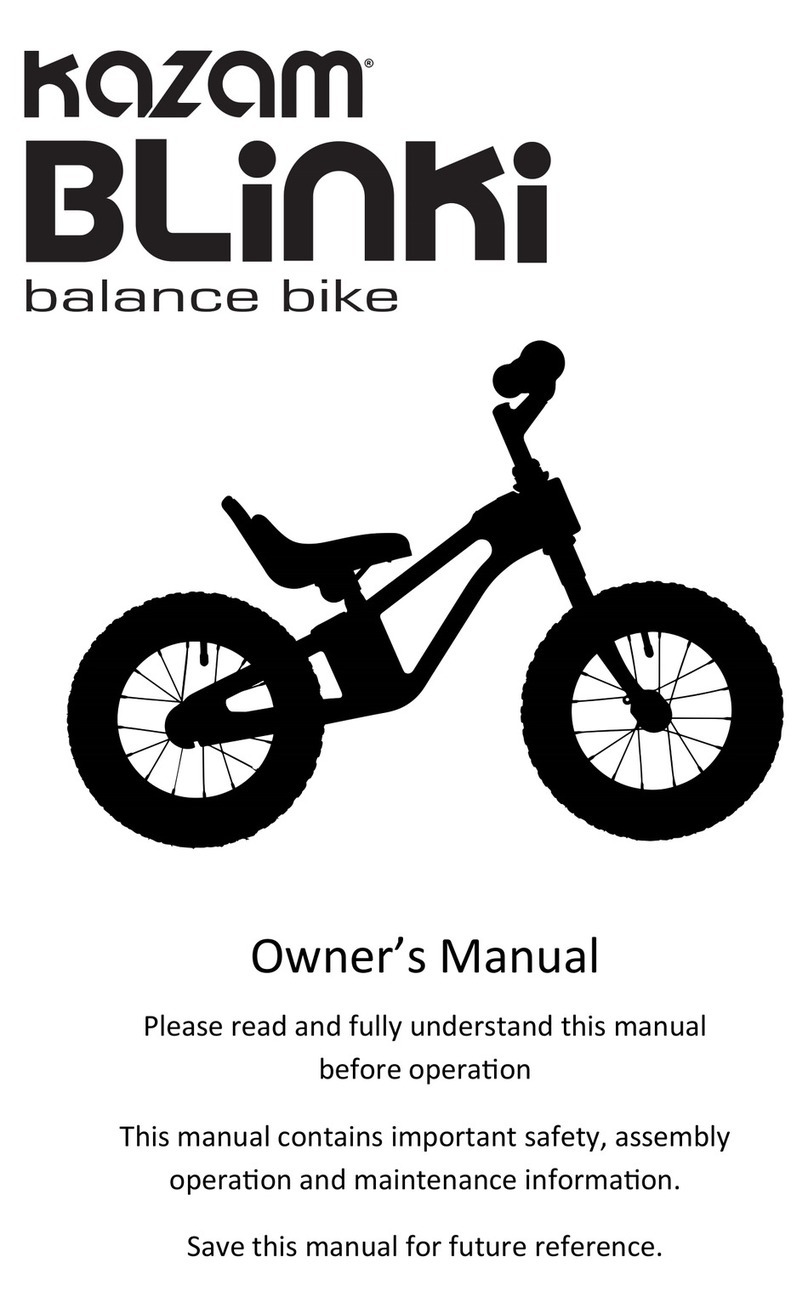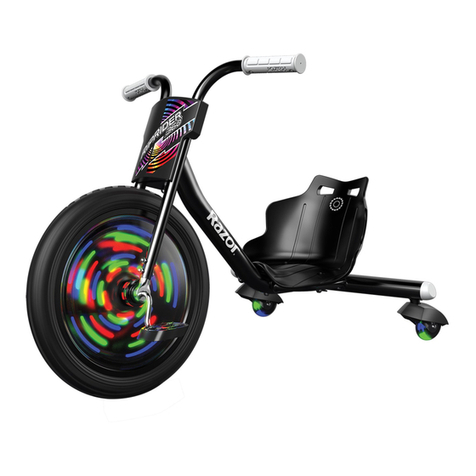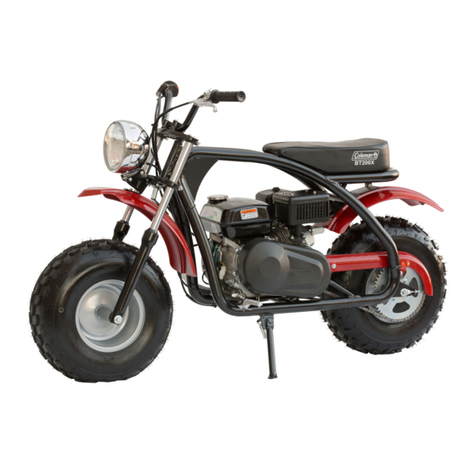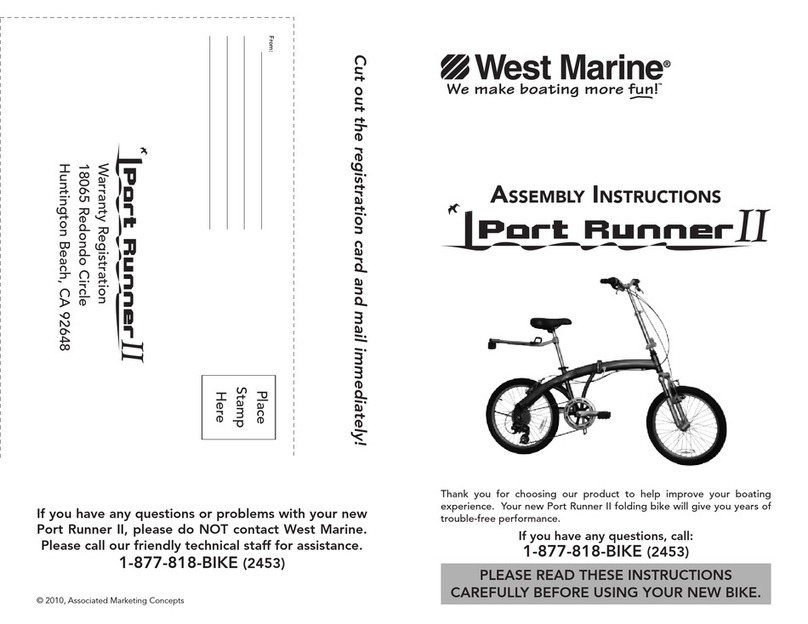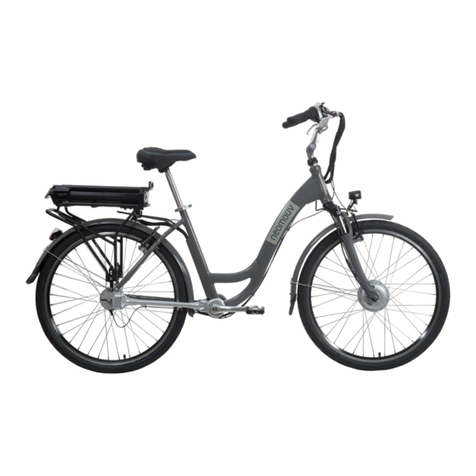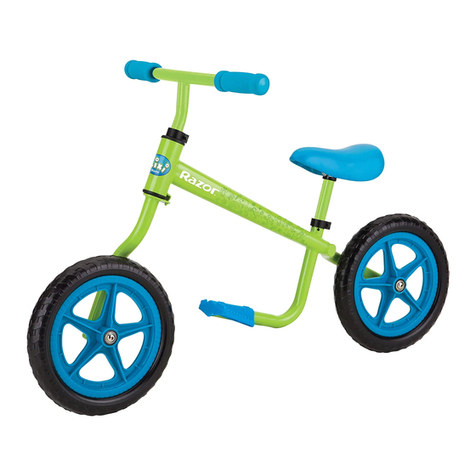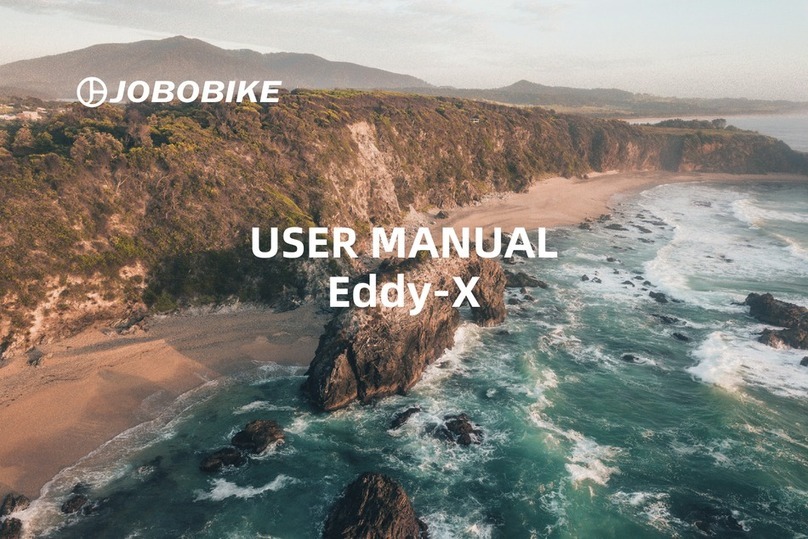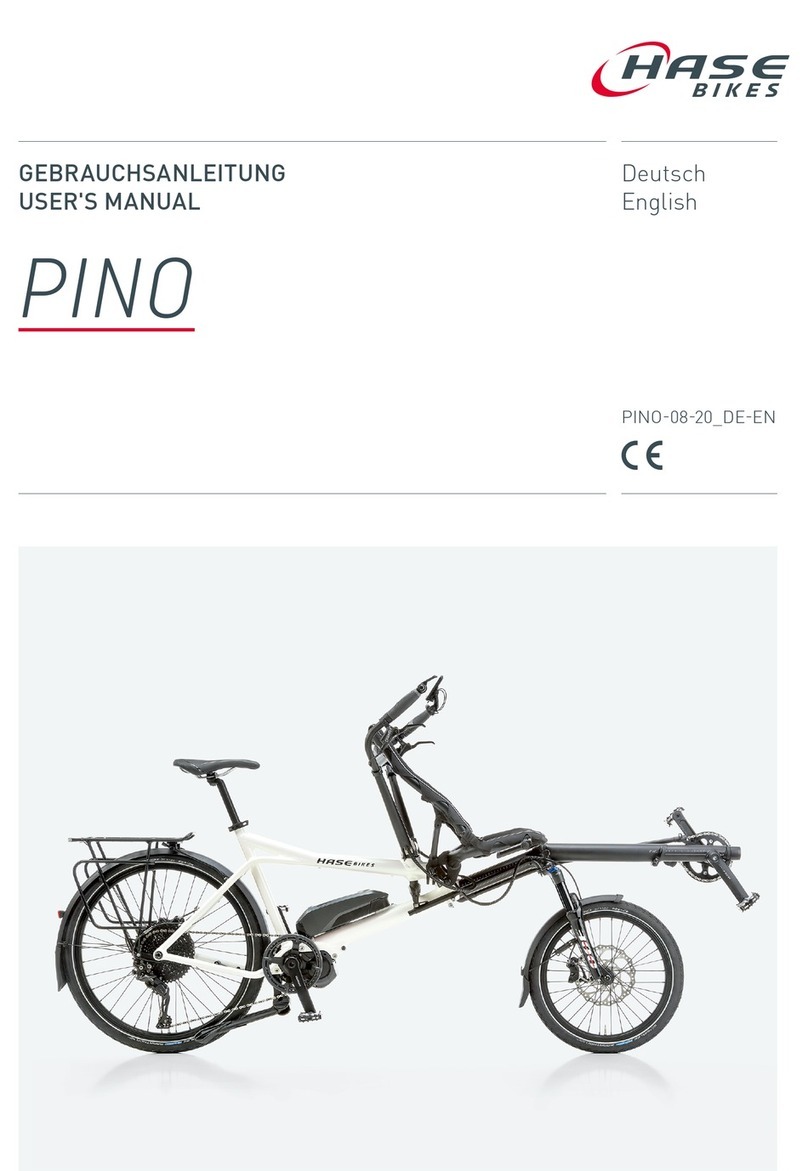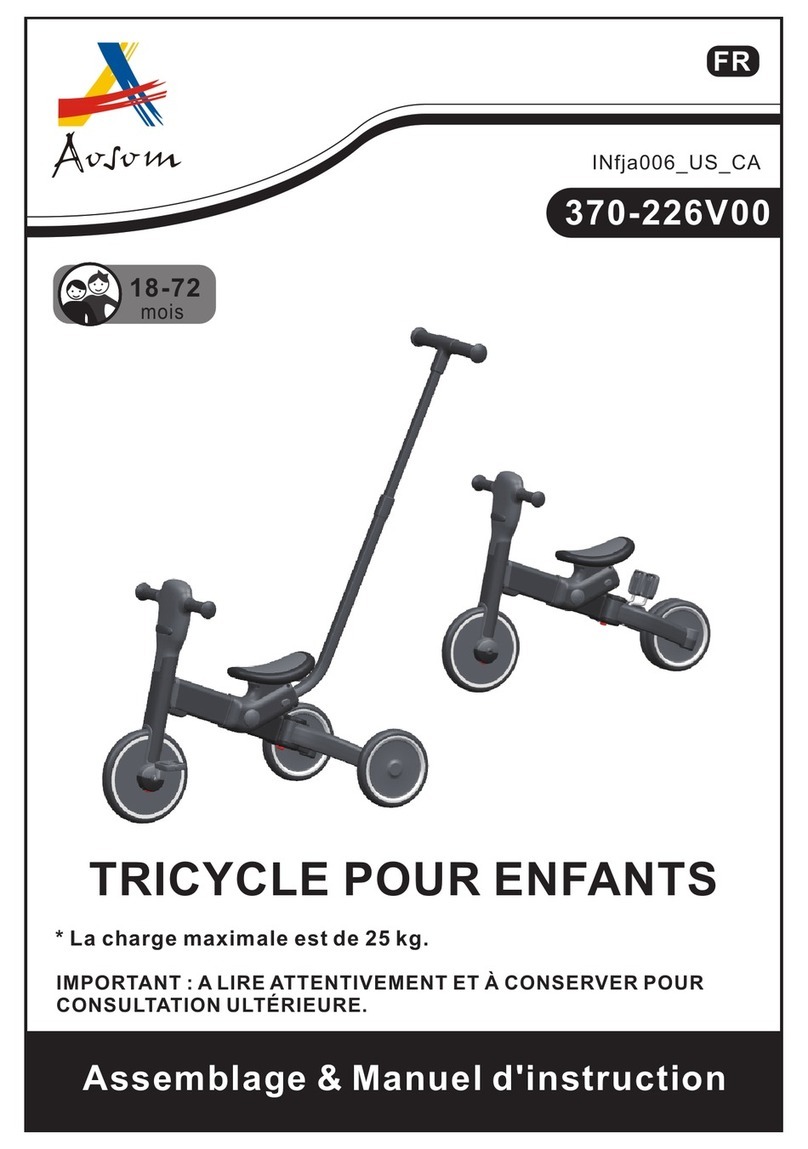Rose electronics Xtra Watt 2019 User manual

OWNER'S MANUAL
V2019.11 XTRA WATT EVO_KIOX_EN

1 Frame 11 Stem
2 Saddle 12 Handlebar
3 Seat post 13 Light
4 Saddle clamp 14 Mudguard
5 Rear rack 15 Fork
6 Rear light 16 Brake disc
7 Mudguard 17 Hub
8 Chain/Belt 18 Spoke
9 Mid-drive motor 19 Rim
10 Pedal 20 Tyre
21 Battery pack
1
2
6
3
7
8
9
4
10
11
14
17
12
13
15
18
19
5
16
20
Translation of original manual
21

Congratulations on the purchase of your ROSE dream bike!
We are pleased that you have decided to buy a ROSE bike and are sure that you will enjoy riding your new bike every
day.
Your bike is unique – before it has found its way to your home, this bike was individually assembled by hand by a
skilled mechanic and carefully inspected by another specialist to ensure it meets our highest quality standards. We thus
guarantee that your bike offers reliability and state-of-the-art technology. Easy-to-use gears and brakes, an excellent
design and great value for money are just some of the reasons why you will love your bike.
Some components were removed or adjusted for shipping. However, they can be easily re-assembled or re-adjusted in
just a few simple steps (see “3. Bike assembly“ on page 14).
Regular care and maintenance (see “9. Maintenance“ on page 35) will prolong the life of your beloved bicycle. This
manual includes all information on handling, maintenance and care you need to properly care for your bike.
We recommend you to carefully check and service your bike at regular intervals. Your safety and a long life of your bike
should be worth the effort.
This manual describes all details you need for a safe use of your bike, as well as the most important and general facts
about your bike. For more detailed information on single bike components, please see the respective owner’s manual
of the manufacturer. All manuals are included in the purchase documents of your bike or available online.
Please take the time to read this manual carefully. The sections marked with the signal words “DANGER“ and
“WARNING“ are of particularly high importance. The instructions contained in these warnings must be followed.
Moreover, we recommend you to follow the steps described in “7. Before and after your ride“ on page 30 and to
have your bike serviced regularly (see “9. Maintenance“ on page 35) to ensure your safety on every ride.
Have fun with your dream bike! Your ROSE Bikes team

1. General information ................................................................................................................ 6
1.1 Explanation of symbols and key words used.........................................................................6
1.2 Target group.....................................................................................................................................6
1.3 Requirements to operate an e-bike ..........................................................................................6
1.4 Owner’s manuals supplied by component manufacturers ...............................................6
1.5 Tools....................................................................................................................................................6
1.6 Installation of components and accessories..........................................................................6
1.7 Replacement of parts ....................................................................................................................7
1.8 Warranty and guarantee...............................................................................................................7
1.9 Wearing parts...................................................................................................................................7
1.10 Weight limit.......................................................................................................................................7
1.11 Exclusion of liability .......................................................................................................................7
2. Safety ........................................................................................................................................ 8
2.1 General safety..................................................................................................................................8
2.2 Carrying children on a bike..........................................................................................................8
2.3 Safe use of the brakes ..................................................................................................................8
2.4 Safe use of the e-bike system ....................................................................................................9
2.5 Safety instructions for the use of Bluetooth devices® ........................................................10
2.6 Safe use of the battery pack .......................................................................................................10
2.7 Safe use of a pannier rack...........................................................................................................11
2.8 Safe use of an adjustable stem..................................................................................................11
2.9 The rider’s duty of care.................................................................................................................12
2.10 Intended use.....................................................................................................................................13
3. Bike assembly.......................................................................................................................... 14
3.1 Opening the ROSE bike box and unpacking the contents ..................................................14
3.2 Straightening the handlebar and adjusting the steering play [Speedlifter Twist].....15
3.3 Adjusting the angle of the handlebar .......................................................................................16
3.4 How to set your saddle height....................................................................................................17
3.5 Installing the pedals.......................................................................................................................18
4. Before your first ride .............................................................................................................. 19
4.1 Checking the battery before the first use ...............................................................................19
4.2 Getting started for your first ride and getting used to your new bike...........................19
5. Riding your e-bike ................................................................................................................... 20
5.1 Information on the e-bike system .............................................................................................20
5.2 Fitting the Kiox on-board computer/
Mounting a smartphone on the SmartphoneHub.................................................................22
5.3 Installing the battery......................................................................................................................23
5.4 Switching the e-bike system on.................................................................................................23
5.5 First use of the e-bike system....................................................................................................24
5.6 Setting the assistance level.........................................................................................................24
5.7 Switching bike lights on/off.........................................................................................................25
5.8 Switching the walk assist function on/off ..............................................................................25
5.9 Interrupting your ride ....................................................................................................................26
5.10 Switching the e-bike system off.................................................................................................26
5.11 Charging the battery ......................................................................................................................27
5.12 Battery charge indicator...............................................................................................................27

6. Cycling with kids...................................................................................................................... 29
6.1 Carrying kids in a bike seat .........................................................................................................29
6.2 Carrying kids in a bike trailer .....................................................................................................29
7. Before and after your ride...................................................................................................... 30
7.1 Before your ride ..............................................................................................................................30
7.2 After your ride..................................................................................................................................32
7.3 After a crash.....................................................................................................................................32
8. Transport, storage and disposal ........................................................................................... 33
8.1 Transport by car..............................................................................................................................33
8.2 Transport on a hitch or roof rack ..............................................................................................33
8.3 Battery storage................................................................................................................................33
8.4 Bike storage......................................................................................................................................33
8.5 Bike shipping....................................................................................................................................34
8.6 Battery shipping ..............................................................................................................................34
8.7 Disposal..............................................................................................................................................34
9. Maintenance ............................................................................................................................. 35
9.1 Bike servicing...................................................................................................................................35
9.2 Replacement of parts ....................................................................................................................36
9.3 Tyre pressure...................................................................................................................................37

6
1. General information
This manual is the most important element to prevent any damages and risks during the assembly, use and servicing of
your new bike. It is provided to give you the most important technical information on your bike, to support you during
bike assembly and to give you helpful tips over the entire life of your bicycle. If in doubt about maintenance works,
please consult a qualified bicycle mechanic.
Please read this manual carefully before taking the first ride on your new bike and make sure you understand
everything. Ensure that third-party users are also informed about the contents of this manual and that they understand
and follow all instructions.
Keep this manual for future reference. If you sell or give away your bike, please also include the owner’s manual.
This manual is additionally available as a pdf file on rosebikes.com/manuals.
1.1 Explanation of symbols and key words used
DANGER
…indicates a hazard with a high level of risk which, if not avoided, will result in death or serious injury.
WARNING
…indicates a hazard with a medium level of risk which, if not avoided, may result in minor or moderate injury.
NOTE
…indicates a potentially hazardous situation that may result in damage to property.
1.2 Target group
This manual is intended for you, the owner of the ROSE bike.
Assembly and maintenance works require basic knowledge in bicycle technology. If in doubt, please consult a qualified
bicycle mechanic. Improper assembly or maintenance of your bike may result in serious injury or death!
1.3 Requirements to operate an e-bike
The rider must be mentally and physically able to safely operate the bicycle over a longer period of time and longer
distances. For newcomers and those getting back into cycling after a long time special cycling skills courses are
recommended.
1.4 Owner’s manuals supplied by component manufacturers
This manual contains all information you need for a safe use of your bike. However, apart from this manual, the
documents supplied with your bike also include some product information or manuals of different component
manufacturers. If need be, you can use those documents for further information on the respective product, its
assembly and setup. The owner’s manuals of some manufacturers might only be available online.
1.5 Tools
All works on your bicycle require appropriate tools. All nuts and bolts must be tightened with an appropriate torque
wrench.
A proper installation and removal of components can only be guaranteed when using perfectly functioning and
undamaged tools.
1.6 Installation of components and accessories
Bicycle trailers must only be fixed to the rear axle of the bike using special hitching devices.
Only use child seats and trailers for clamp mounting on the seat tube of men's and unisex bicycle frames.
Do not mount any child seats and trailers with clamp mount on the seat tube of bicycles with a low entry.
It is not allowed to mount trailers or child seats on the seat post.
Racks must only be attached to special fixing points designed for this purpose.
Make sure to read the manufacturer’s manual before installing components and accessories.
Make sure to not exceed the maximum system weight (see “1.10 Weight limit“ on page 7) even with all add-on parts
and accessories fitted!

7
1.7 Replacement of parts
As e-bike components are subjected to heavy loads, you cannot simply replace them. In most cases, you must obtain
approval from ROSE Bikes or the component manufacturer before replacing a component. Also see “9.2 Replacement
of parts“ on page 36.
Please contact ROSE Bikes in case of any questions.
1.8 Warranty and guarantee
For all information on warranty and guarantee see rosebikes.com/termsandconditions.
Tuning the e-bike will invalidate the warranty.
If you have purchased a complete bike from us, you are obliged to return the entire bike to make a warranty claim, and
not just the defective components. Only then we can check whether the legal requirements for a warranty claim are
met.
1.9 Wearing parts
Therefore, the components listed below should be checked regularly and replaced, if necessary:
• Battery pack and drive unit
• Tyres and tubes
• Rims
• Brake pads
• Bearings (headset bearings, bottom bracket bearings, rear triangle bearings, hub bearings)
• Chain and drive belt
• Cassette and sprockets
• Handlebar, grips and stem
• Saddle and seat post
• Grease, lubricant, hydraulic oil and brake fluid
• Inner and outer brake and gear cables
• Suspension fork and rear shock
• Stickers and paintwork
1.10 Weight limit
Electric ROSE bikes are designed for a maximum weight of 140 kg. The system weight is derived from the weight of the
cyclist, bicycle, gear (helmet, backpack, shoes, clothes) and luggage.
1.11 Exclusion of liability
The tasks described in this manual require special knowledge and should only be carried out by people with sufficient
expertise.
The user is liable for damages resulting from:
• Misuse or any other cause beyond the range of the intended use (see “2.10 Intended use“ on page 13)
• Non-compliance with safety regulations
• Improper assembly, repair and maintenance
• Use of unapproved replacement parts and accessories
• Change of construction
• Tuning
If in doubt, please consult the ROSE service or a qualified bicycle mechanic.

8
2. Safety
2.1 General safety
DANGER
Inadequate protective equipment can cause injuries!
Effective safety equipment contributes to your personal safety.
• Always wear a helmet.
• Always wear highly visible and reflective clothing.
DANGER
Improperly installed components can cause serious crashes!
Improperly installed components may loosen during the ride!
• Always follow the installation instructions included in this manual.
• If in doubt, please consult the ROSE service or a qualified bicycle mechanic.
DANGER
Risk of accident due to sudden total failure of pre-damaged components!
A fall or unforeseeable manoeuvres can pre-damage components of your bike. Even though you might not
immediately notice those damages, it is always possible that pre-damaged components deform or break while riding.
• Regularly check your components for damages.
• Components that are subject to high stress must be regularly replaced and checked by a qualified bicycle
mechanic.
2.2 Carrying children on a bike
DANGER
Risk of injury when carrying kids in a bike seat or bike trailer!
Carrying children in a bike seat or bike trailer inappropriately may lead to accidents with a high injury potential.
• Please note the information in chapter “6. Cycling with kids“ on page 29.
• Never carry a child in a bike seat or a bike trailer if not all of the conditions in chapter “6. Cycling with kids“ on
page 29 are complied with.
2.3 Safe use of the brakes
DANGER
Risk of accident due to reduced braking performance caused by brake pads that are not broken in!
Disc brakes can only achieve full braking power when the brake pads are broken in. Choose a place off public roads
to break in the pads.
• Brake 20 to 30 times with the front or rear brake from a speed of 30 km/h down to 5 km/h and repeat the
process for the second brake. You should brake as hard as possible without locking one of the wheels.
• Please also see the brake manufacturer’s instructions for more information (see enclosed manual).

9
DANGER
Risk of accident due to high braking power of the disc brakes!
Modern disc brakes have a very high braking power. Sudden braking may cause losing control of your bicycle.
• Make yourself familiar with the power and operation of your disc brakes off public roads.
2.4 Safe use of the e-bike system
DANGER
Using the on-board computer while riding increases the risk of accidents!
Reading from the computer display or changing settings while riding may distract from the traffic situation. This may
result in accidents caused by delayed or hindered rider responses!
• For all settings other than those concerning the level of assistance, you should stop on the side of the road to
enter respective data.
DANGER
Risk of accident due to misjudgement through other road users!
Other road users mostly misjudge the speed of e-bike riders.
• Always ride carefully and never rely on other road users to react properly.
DANGER
Danger caused by increasing the maximum speed or speed limitation of the e-bike!
Pedelec tuning bears incalculable liability risks as well as the risk of irreversible damage to the system!
• It is not permissible to modify the e-bike drive system.
• It is not permitted to mount any products that might be able to increase the power of the e-bike system.
• Improper use of the drive system endangers your safety and the safety of other road users.
• When causing accidents due to manipulations, you risk high liability costs and criminal prosecution.
• All components are adapted to the original performance data of the e-bike. Higher loads may overload the
system, reduce its life and irreversibly damage the system on the long term.
• Guarantee and warranty claims are lost.
WARNING
Risk of injury due to accidental activation of the e-bike drive system!
• Always remove the battery pack from the e-bike before working on the electric bicycle (e.g. servicing, repair,
assembly, maintenance works), as well as before transport (e.g. by car or plane) and storage.

10
NOTE
Risk of damage to the on-board computer!
Improper handling may cause irreparable damage to the on-board computer or its holder.
• Do not use the on-board computer as a handle.
Lifting the e-bike up by the on-board computer can cause irreparable damage to the on-board computer.
• Do not stand your bicycle upside down on its saddle and handlebar.
This may irreparably damage the on-board computer or holder.
• Remove the on-board computer before clamping the bike into a repair stand to ensure that the on-board
computer does not fall off or get damaged.
2.5 Safety instructions for the use of Bluetooth devices®
NOTE
Special instructions for the use of the Bluetooth® function of the on-board computer
Using the on-board computer with
Bluetooth
®
may cause interference affecting other devices and systems, aeroplanes
and medical devices (e.g. pacemakers, hearing aids). Injury to people and animals in the immediate vicinity cannot be
excluded entirely.
• Do not use the on-board computer with Bluetooth®in the vicinity of medical devices, petrol stations, chemical
plants, areas with a potentially explosive atmosphere or on blast sites.
• Do not use the on-board computer with Bluetooth®in aeroplanes.
• Avoid using the on-board computer near your body for extended periods.
• Local operating restrictions, e.g. in aeroplanes or hospitals, must be observed.
The Bluetooth®word mark and logos are registered trademarks owned by Bluetooth SIG, Inc.
2.6 Safe use of the battery pack
In addition to the safety instructions below, please also follow the instructions described in “8. Transport, storage and
disposal“ on page 33.
DANGER
Short circuits, explosions and electrical fire can cause serious injuries!
• Batteries must not be subjected to mechanical impacts.
• Do not open the battery pack. Otherwise, there is the risk of a short circuit.
• Keep the battery away from heat (and out of permanent sunlight) and fire and never drop it into water.
• Do not store or operate the battery near hot or inflammable objects.
• Keep the battery away from paper clips, coins, keys, nails, screws or other metal items when not in use to
prevent shorting exposed battery contacts.
DANGER
Risk of injury due to improper charging of the battery!
Improper charging may cause the battery or other inflammable materials nearby to catch fire.
• Only use the original charger.
• Do not locate the charger or battery near inflammable materials while charging.
• Only charge the battery when dry.
• Do not leave the battery unattended while charging it.

11
DANGER
Risk of injury due to escaping liquids or vapours!
• Damages or improper use may cause liquid to escape from the battery. This may cause skin irritation, eye
irritation or burns!
• Avoid contact with skin and eyes.
• In case of contact with skin, wash off with water.
• In case of contact with the eyes, seek medical assistance.
• Damages or improper use may cause vapours to escape from the battery. These may be irritant to the respiratory
system!
• Seek fresh air and medical attention, if need be.
WARNING
Risk of accident due to incorrect handling of the battery or its use in a way that is not intended!
• Only use the battery in combination with the appropriate e-bike drive system.
• Only use approved models when replacing the battery pack.
2.7 Safe use of a pannier rack
WARNING
Improper handling of a pannier rack may cause you to fall!
Improper handling of a pannier rack or the luggage attached to it may lead to serious crashes.
• Never exceed the rack’s maximum load limit. Check the pannier rack or the manufacturer’s manual for the
maximum load limit (also see “1.4 Owner’s manuals supplied by component manufacturers“ on page 6).
• Do not exceed the load limit of the bicycle even when the rack is loaded (see “1.10 Weight limit“ on page 7).
• A loaded rear rack may change the steering and braking characteristics of your bike.
• Always attach additional accessories for the rack (e.g. panniers) according to the manufacturer’s instructions.
• Ensure lights or reflectors are not obstructed when the pannier is attached.
• Distribute weight evenly on both sides of the rack.
• Secure luggage against sliding or falling down. Make sure there are no loose parts hanging down.
• Secure and regularly check the rack’s mounting brackets.
• Racks must not be modified.
• Do not attach trailers to the rack.
2.8 Safe use of an adjustable stem
WARNING
Risk of accident due to improper use of a stem with adjustable height and angle!
An improperly adjusted or tightened stem can cause you to lose control and fall.
• Do not adjust the height of your stem while riding.
• Make sure the stem is positioned and tightened properly before riding the bicycle.
WARNING
Risk of accident due to the use of a conventional stem on a steerer that is designed for Speedlifter stems!
The installation of a Speedlifter system requires a modification of the steerer tube. A Speedlifter stem must not be
replaced with a conventional stem.
• The replacement of a Speedlifter system with a conventional stem requires a special adapter and must be carried
out by a qualified bicycle mechanic.

12
2.9 The rider’s duty of care
Following the instructions specified in this manual does not absolve the riders from their duty of care to ensure that
their bike is always in good condition. If there are any questions consult a qualified bicycle mechanic or the ROSE
Service.

13
2.10 Intended use
The intended use of ROSE bikes is divided into five different categories – ranging from the use on paved roads through
to downhill or freeride use. The bikes must only be used in accordance with their intended purpose/use. Otherwise, the
user takes responsibility.
A sticker on the frame of your bike will show you the intended use.
1
Category 1: For use on paved roads only
Category 1 includes all bikes and components that should only be used on paved roads.
The wheels are always in contact with the ground.
2
Category 2: For use on and off the road and for drops of up to 15 cm
Category 2 includes all bikes and components that can be used in conditions described under
category 1, as well as on gravel roads and moderate trails. The wheels may also loose contact
with the ground. Drops should not be higher than 15 cm.
3
Category 3: For use in rough terrain and for jumps of up to 61 cm
Category 3 includes all bikes and components that can be used in conditions described under
category 1 and 2, as well as on rough trails and rough and unpaved roads that require good
cycling skills. Jumps and drops should not be higher than 61 cm.
4
Category 4: For use in rough terrain and for jumps of up to 122 cm
Category 4 includes all bikes and components that can be used in conditions described under
category 1, 2 and 3, as well as for higher speeds on rough and steep trails. Jumps should not be
higher than 122 cm.
5
Category 5: Extreme biking (Downhill, Freeride, Dirt)
Category 5 includes all bikes and components that can be used in conditions described under
category 1, 2, 3 and 4, as well as for extreme jumps and high-speed riding on rough trails and in
bike parks.
Dirt and slopestyle bikes are not designed for downhill riding. For high drops or jumps with
flat or rough landings, you need a long-travel bike (freeride or downhill bikes). Dirt bikes are
designed for dirt jumping and for use in skateparks or on pump tracks. The riders should always
wear protective clothing and armour like a helmet/full face helmet, knee pads, elbow guards,
back protectors and gloves.
When using your bike regularly in conditions described under category 5, you should check and
replace the most stressed components more often.

14
3. Bike assembly
This chapter aims at helping you remove your bike from the ROSE bike box and re-assemble it.
Depending on the bike model, different components may have been removed or repositioned for shipping. In addition,
you have to fit the pedals and check whether your bike is in a roadworthy condition.
DANGER
Improperly installed components can cause serious crashes!
Improperly installed components may loosen during the ride!
• Always follow the installation instructions included in this manual.
• If in doubt, please consult the ROSE service or a qualified bicycle mechanic.
In addition to this manual, you will find some videos on how to assemble your bike at rosebikes.com.
Required tools
Depending on bike model and equipment, you will need the following tools for assembly:
• 4 mm, 5 mm, 6 mm, 8 mm hex wrench
• Torque wrench with a 4 mm, 5 mm, 6 mm and 8 mm hex drive
• 15 mm open-ended spanner
3.1 Opening the ROSE bike box and unpacking the contents
Before opening, check the ROSE bike box for any damages. After that, check the contents
for completeness! Please notify all possible defects immediately!
The bike box of ROSE e-bikes is designed to allow you to wheel the bike out of the box. For
this, please open the box on the small side.
1. Carefully open the ROSE bike box on one of the narrow sides. Make sure not to damage
any parts especially when using a knife.
2. Wheel the bike out of the bike box and unpack all other contents.
3. Remove – if present – any transport locking devices from the frame.
Keep hold of the ROSE bike box! You might need it to return the bike for servicing or repair.

15
3.2 Straightening the handlebar and adjusting the steering play [Speedlifter Twist]
CAUTION
The adjusting bolt for the steering play does not serve to tighten the stem, but only to adjust the play in the steering
bearing!
1
2
5
4
3
1. Open the quick-release lever (4).
2. Press the safety lever (5) to the top and hold it in position.
3. Turn the handlebar to the direction of travel.
4. Let the safety lever (5) go and close the quick-release lever (4).
5. Check the steering bearing for play by pulling the front brake and trying to push the bike gently backwards and
forwards.
→There must be no play.
6. If you feel any movement inside the headset:
• Turn the clamp bolt (2) on the Speedlifter (1) anti-clockwise for one to two turns.
• Use a 36 mm combination wrench to turn the adjustment ring (5) clockwise in small increments until you do no
longer notice any play.
→After the steering head bearings have been adjusted, no more than 3 of the adjustment ring‘s (3) thread turns
should be visible. If more than 3 thread turns are visible, ask a qualified bicycle mechanic to adjust the headset
play.
• Tighten the clamp bolt (2) to a torque of 6 to 8 Nm.
7. Check the headset once again for play and repeat the previous steps, if need be, until there is no more play inside
the bearing. If in doubt, seek professional advice from a qualified bicycle mechanic.

16
3.3 Adjusting the angle of the handlebar
1. Loosen the handlebar clamp bolts by turning them anti-clockwise until the angle of your handlebar can be
adjusted.
2. Check whether there is a protective film between handlebar and stem.
If there is a protective film:
2.1 Completely loosen the handlebar clamp bolts and remove
the handlebar clamp(s).
2.2 Remove the handlebar and take off the protective film.
2.3 Re-install the handlebar and handlebar clamp(s).
2.4 Turn the clamp bolts clockwise and tighten them just
enough so that the handlebar can still be moved.
3. Centrally align the handlebar and adjust the angle.
4. Tighten the bolts of the handlebar clamp alternately in small
increments until you have reached a tightening torque of 4 Nm.

17
3.4 How to set your saddle height
DANGER
Extending the seat post past the minimum insertion mark may cause accidents or damage!
If the seat post is not inserted to the minimum insertion mark, it may break or damage the frame.
• The seat post must not be extended further than the limit mark.
• When cutting down the seat post, the original minimum insertion mark is no longer valid. Make sure to insert the
seat post at least 10 cm into the frame.
1. Open the saddle clamp.
2. Change the height of the saddle by sliding the seat post up or
down and make sure the saddle is straight.
The seatpost comes with a minimum insertion line marked on
it. Make sure that this line is not visible after adjusting the saddle
height!
MIN INSERT
3. Tighten the bolt of the seat clamp to a torque of 6 Nm.
6 Nm
4. Get on your bike and check whether the saddle height is right.
→It should be safe to get on and off the bike.
→Make sure your toes can touch the ground when standing still.

18
3.5 Installing the pedals
One of the pedals has a right- and the other a left-hand thread.
Most pedals have the letter “L” and “R” stamped on the end of the thread. Some pedals come with a groove in
the flange of the left pedal.
For more information see the manufacturer‘s manual.
1. Check if your bike was supplied with washers and slide both
washers onto the pedal axles – if present.
2. Turn the left pedal counter-clockwise to screw it into the thread
of the left crank arm and tighten the pedal to a torque of
35Nm.
35 Nm
3. Turn the right pedal clockwise to screw it into the thread of the
right crank arm and tighten the pedal to a torque of 35Nm.
35 Nm
Your bike is now completely assembled. Before riding off, you should follow the steps described in the chapters
“Getting started for your first ride and getting used to your new bike” and “Before your ride”.

19
4. Before your first ride
4.1 Checking the battery before the first use
1. Switch on the e-bike system (see “5.4 Switching the e-bike system on“ on page 23).
2. Check the battery charge (see “5.12 Battery charge indicator“ on page 27).
4.2 Getting started for your first ride and getting used to your new bike
Make yourself familiar with the handling, brakes, shifting system and – if available – with the suspension elements of
your bike away from public roads. Do not forget to wear a helmet! Only slowly increase the difficulty of the terrain or
manoeuvres.
Requirements:
• The bike is assembled in accordance with chapter “Bike assembly” (see “3. Bike assembly“ on page 14).
• The saddle height is properly adjusted to guarantee a comfortable ride and to ensure you will get on and off the
bike easily.
• All tasks from chart “Before your ride” (see “7.1 Before your ride“ on page 30) have been carried out.
1. Break in the brake pads.
Choose a road away from public roads and brake 20 to 30 times with the front or rear brake from a speed of
30km/h down to 5km/h. You should brake as hard as possible without locking one of the wheels. Repeat the
process for the other brake. Only then the brake can show its full braking power.
Please note the brake manufacturer’s instructions for more information (see enclosed manual).
2. Check the functioning of the brakes while riding.
Normally, the rear brake is located on the right-hand side of the handlebar, and the front brake is on the left-
hand side. However, if required, the brake levers can also be mounted the other way around.
If the positioning of the brake levers on your bike is new and unfamiliar, you will have to be careful on your
first rides. Make yourself familiar with the functioning and power of the brakes while riding at reduced speed.
Many brakes offer the possibility to adjust bite point and lever reach. Please see the brake manufacturer’s
instructions for more information (see enclosed manual).
Shifting system:
3. Shift through all gears while riding at reduced speed and choose the right gear.

20
5. Riding your e-bike
5.1 Information on the e-bike system
Your bike either comes with a Kiox display or a SmartphoneHub.
5.1.1 Kiox on-board computer
1 Display
2 Bike light button „ “
3 On/off button
4 Holder
5 USB port with cover
The Kiox on-board computer features a Bluetooth®
interface and allows for a wireless connection
to a smartphone via a respective app. For further
information visit wwww.Bosch-eBike.com.
Technical data of the Bluetooth interface:
Frequency: 2400 - 2480 mHz
Transmission
power:
< 10 mW
5.1.2 SmartphoneHub
1 Display
2 On/off button „ “
3 USB port with cover
1
2
3
4
5
1
2
3
Table of contents
Other Rose electronics Bicycle manuals
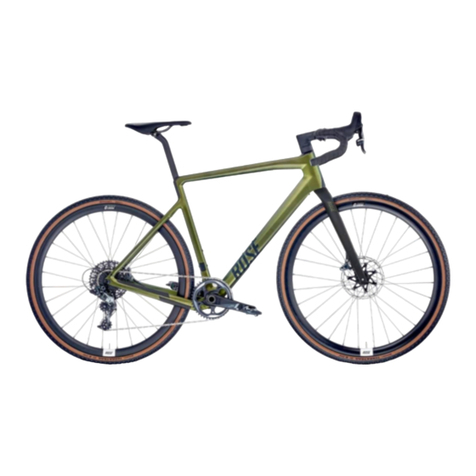
Rose electronics
Rose electronics BACKROAD User manual
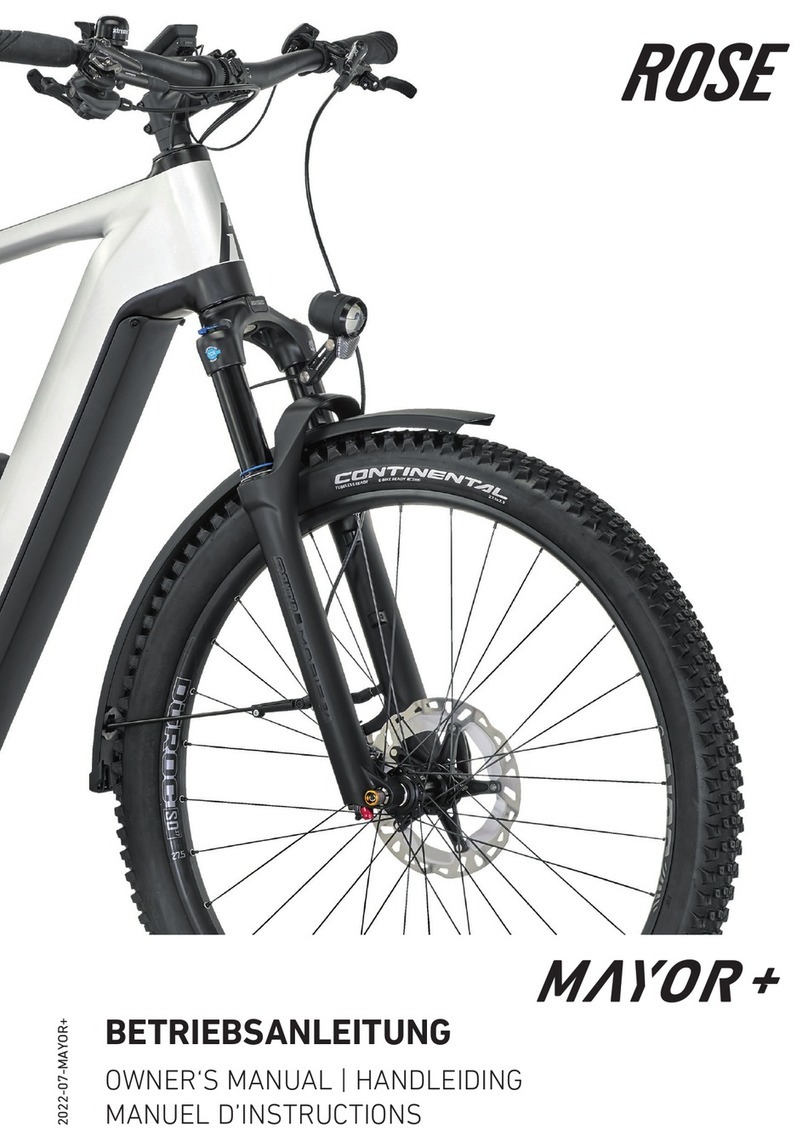
Rose electronics
Rose electronics MAYOR + User manual
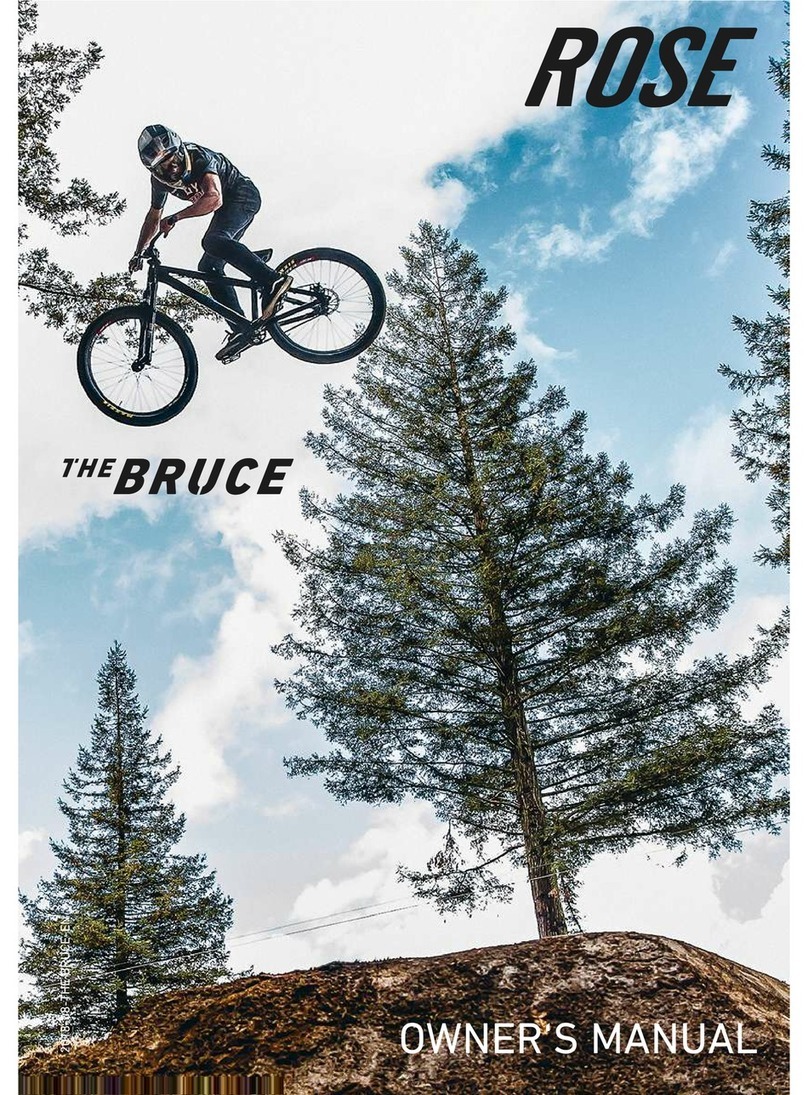
Rose electronics
Rose electronics The Bruce User manual
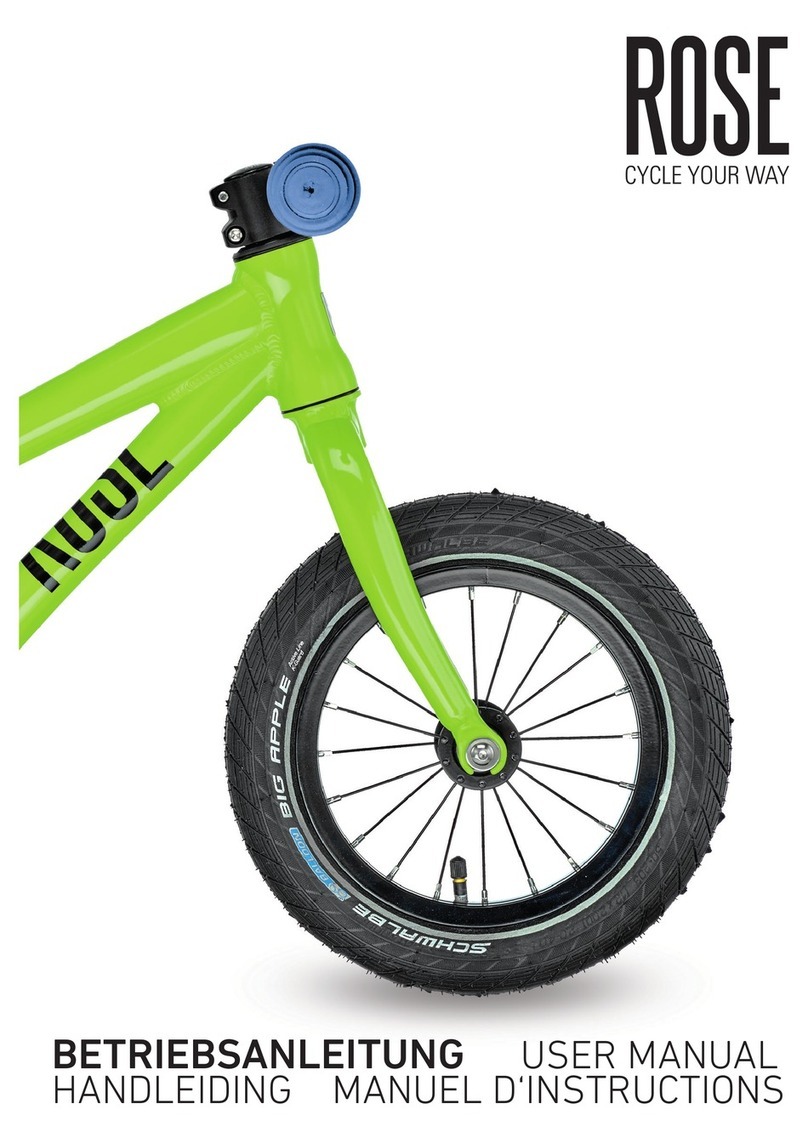
Rose electronics
Rose electronics 2260601 User manual
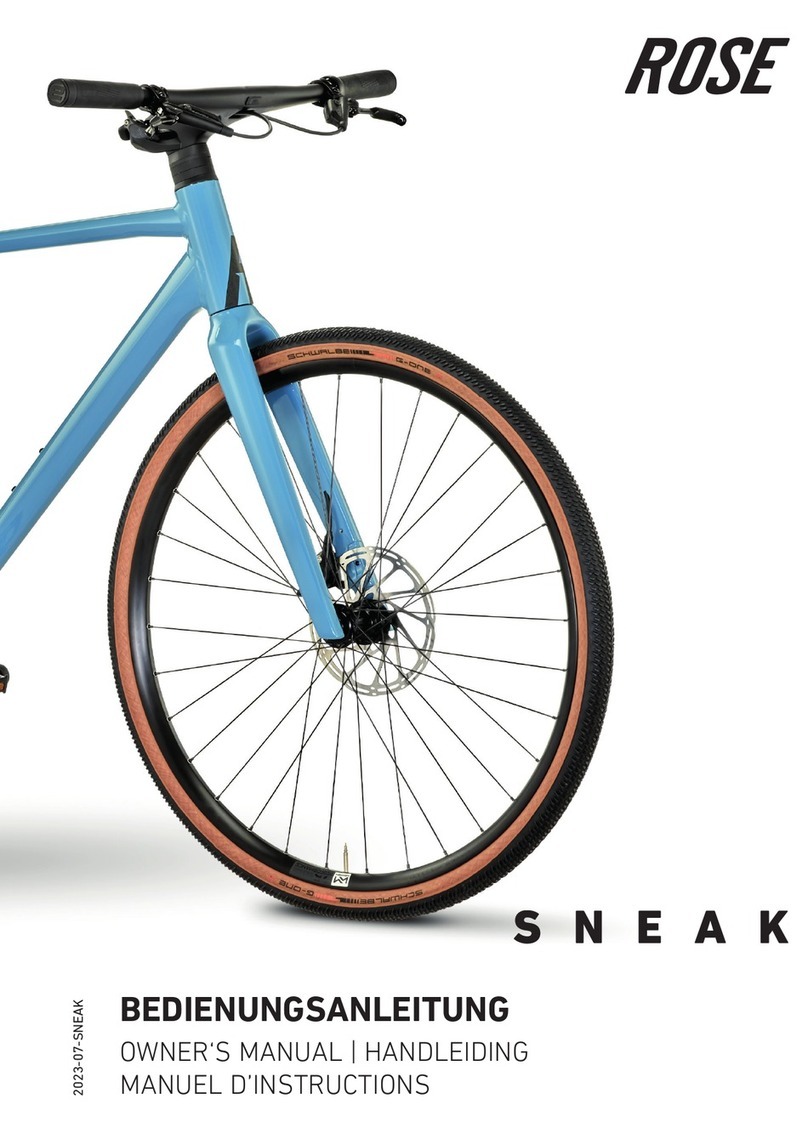
Rose electronics
Rose electronics SNEAK User manual
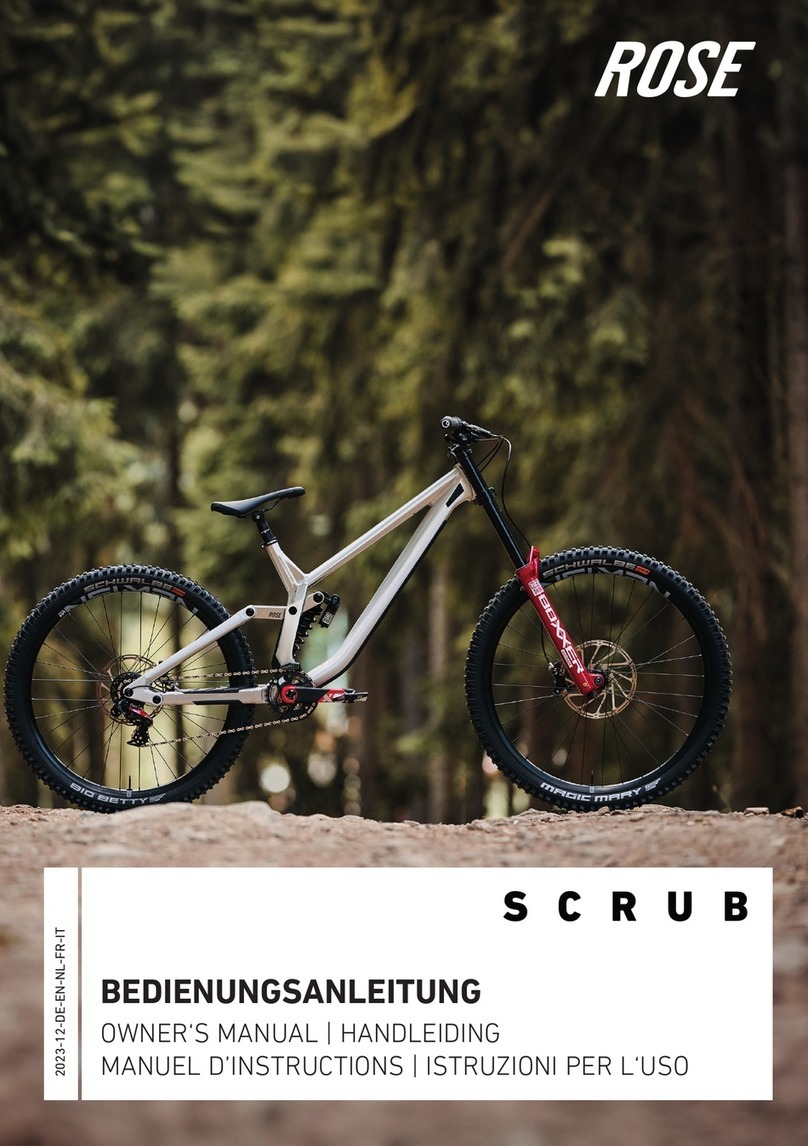
Rose electronics
Rose electronics SCRUB User manual

Rose electronics
Rose electronics The Bruce User manual

Rose electronics
Rose electronics MULTI SPORT User manual

Rose electronics
Rose electronics BACKROAD+ User manual

Rose electronics
Rose electronics BONERO User manual
